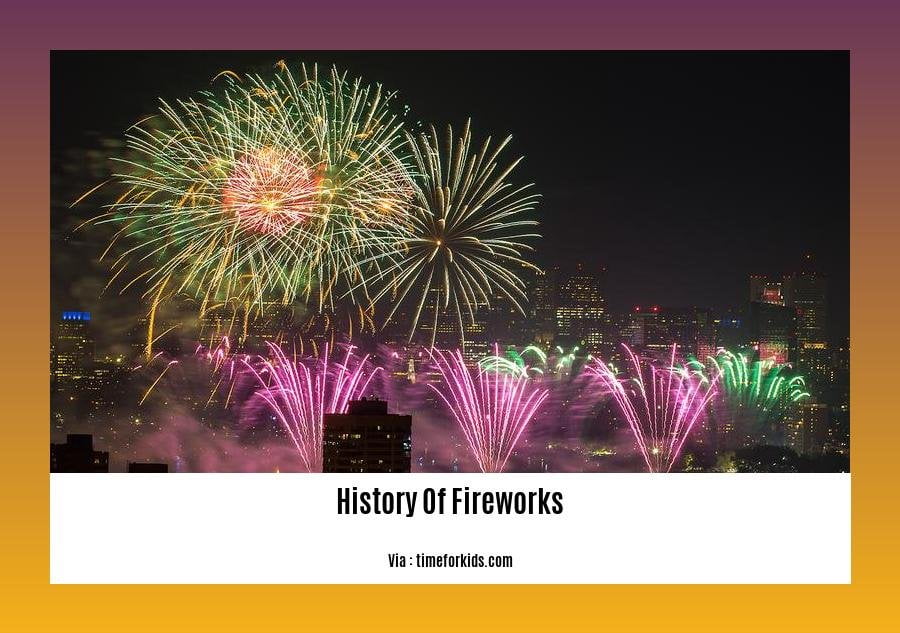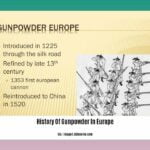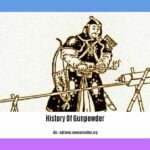Embark on [A Journey Through Time: The Enchanting History of Fireworks], an illuminating exploration of pyrotechnic artistry from its humble origins to its global acclaim. Unravel the fascinating tales behind the crackling brilliance that has captivated cultures across continents and centuries.
Key Takeaways:
- Fireworks originated in China around 2000 years ago by accident.
- They were initially used to scare away evil spirits and for entertainment.
- Gunpowder and metal shavings added by Li Tian enhanced fireworks with colorful sparks and flashes.
- Trade and warfare brought fireworks to Europe and the Middle East.
- Fireworks evolved into elaborate and artistic displays with diverse shapes, colors, and effects.
- Today, fireworks are a global phenomenon for festivals, holidays, and special events.
A Journey Through Time: A Brief history of fireworks**


Fireworks: A Serendipitous Discovery
The history of fireworks originates in ancient China, where they were discovered accidentally around 2000 years ago. It is believed that a cook stumbled upon this enchanting spectacle while experimenting with a mixture of charcoal, sulfur, and saltpeter. Over the centuries, fireworks have undergone a remarkable evolution, transforming from simple sparks into captivating displays of artistry and wonder.
The Cradle of Fireworks: Ancient China
China played a pivotal role in the history of fireworks. By the 9th century, fireworks had become an integral part of Chinese culture, serving both practical and entertainment purposes. They were utilized to ward off evil spirits and enhance festive celebrations. A significant breakthrough occurred when a monk named Li Tian incorporated gunpowder and metal shavings into the mix, giving rise to brilliant colors and mesmerizing sparks.
A Global Phenomenon
Through trade and military campaigns, fireworks found their way to Europe and the Middle East, captivating audiences worldwide. They quickly gained popularity for their ability to add grandeur to celebrations, provide entertainment at festivals, and serve strategic purposes in warfare. Over time, fireworks became increasingly elaborate, with skilled artisans developing intricate shapes, vibrant colors, and mesmerizing effects through innovative chemical and physical techniques.
The Modern Marvel
Today, fireworks are a truly global phenomenon, illuminating the skies of nations and cultures far and wide. They continue to hold a special place in our hearts, marking milestones, holidays, and special events with their awe-inspiring displays. The history of fireworks is a testament to the enduring power of human ingenuity, showcasing our ability to transform scientific discoveries into captivating spectacles of joy and wonder.
Discover the fascinating origins of fireworks, tracing their journey from ancient China to their adaptations in Europe and beyond until their evolution into the modern pyrotechnics we enjoy today modern pyrotechnics.
History of Fireworks in Europe: IELTS Listening
As civilizations advanced, so did our ability to illuminate the night sky with dazzling displays of fireworks. Europe played a pivotal role in the evolution of pyrotechnics, contributing to the vibrant traditions and captivating spectacles we enjoy today.
Fireworks made their way to Europe from China via the Silk Road in the 13th century. Initially used for military signaling and religious ceremonies, they soon found their niche as a form of entertainment. Italians and Germans, with their expertise in chemistry and metallurgy, refined firework compositions, creating a wider range of colors and effects.
The 17th and 18th centuries witnessed a surge in firework artistry. Royal courts and wealthy patrons commissioned elaborate pyrotechnic displays to celebrate special occasions and impress visitors. The use of fireworks became entwined with festivals, public holidays, and military triumphs.
In the 19th century, the invention of new chemical mixtures and combustible materials led to even more spectacular displays. The development of rockets and shells allowed fireworks to reach greater heights and create intricate aerial patterns.
Key Takeaways:
- Fireworks originated in China and reached Europe via the Silk Road.
- Italians and Germans played a significant role in refining firework compositions.
- The 17th and 18th centuries saw a surge in firework artistry.
- The 19th century brought about the invention of new chemical mixtures and combustible materials.
Sources:
- History of Fireworks | Live Science
- The Evolution of Fireworks | Smithsonian Science Education Center
FAQ
Q1: When were fireworks invented, and where did they originate?
A1: Fireworks were first invented in China around 2000 years ago by accident when a cook mixed charcoal, sulfur, and saltpeter.
Q2: How did fireworks spread to Europe and the Middle East?
A2: Fireworks spread to Europe and the Middle East through trade and war, becoming popular for celebrations, entertainment, and military purposes.
Q3: Who was responsible for improving fireworks by adding gunpowder and metal shavings?
A3: A monk named Li Tian improved fireworks by adding gunpowder and metal shavings, creating colorful sparks and flashes.
Q4: What was the significance of Chinese scientists and technicians in the development of fireworks in Europe?
A4: The history of fireworks in Europe reveals the changing roles of scientists and technicians in Europe.
Q5: What is the global impact of fireworks today?
A5: Today, fireworks are a global phenomenon, used to mark festivals, holidays, and special events worldwide.
















